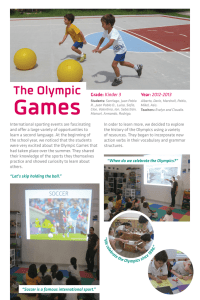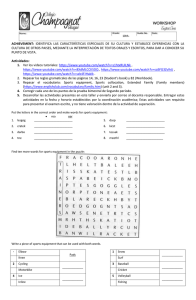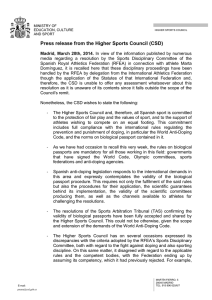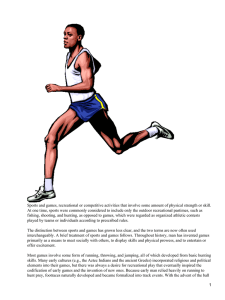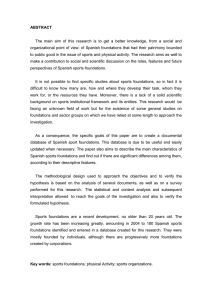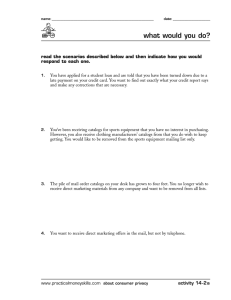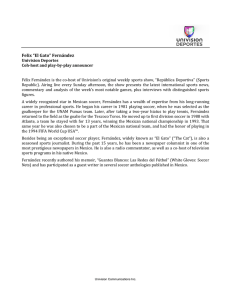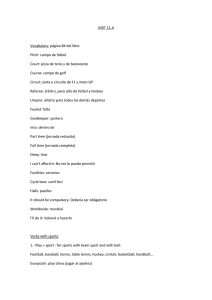alabarces-Sport relations AL-EU en Bonet, Schargorodsky (eds.) (2019) Challenges of Cultural relations
Anuncio
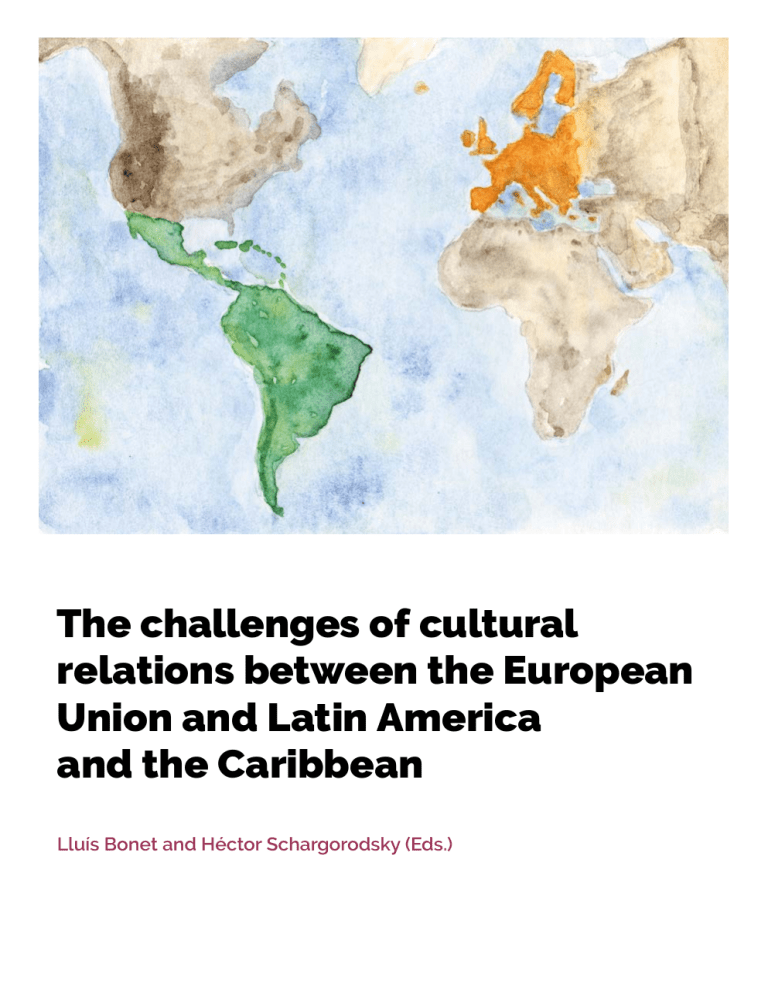
The challenges of cultural relations between the European Union and Latin America and the Caribbean Lluís Bonet and Héctor Schargorodsky (Eds.) The challenges of cultural relations between the European Union and Latin America and the Caribbean Lluís Bonet and Héctor Schargorodsky (Eds.) Title: The Challenges of Cultural Relations between the European Union and Latin America and the Caribbean Editors: Lluís Bonet and Héctor Schargorodsky Publisher: Quaderns Gescènic. Col·lecció Quaderns de Cultura n. 5 1st Edition: August 2019 ISBN: 978-84-938519-4-1 Editorial coordination: Giada Calvano and Anna Villarroya Design and editing: Sistemes d’Edició Printing: Rey center Translations: María Fernanda Rosales, Alba Sala Bellfort, Debbie Smirthwaite Pictures by Lluís Bonet (pages 12, 22, 50, 132, 258, 282, 320 and 338), by Shutterstock.com, acquired by OEI, original photos by A. Horulko, Delpixel, V. Cvorovic, Ch. Wollertz, G. C. Tognoni, LucVi and J. Lund (pages 84, 114, 134, 162, 196, 208, 232 and 364) and by www.pixnio.com, original photo by pics_pd (page 386). Front cover: Watercolor by Lluís Bonet EULAC Focus has received funding from the European Union’s Horizon 2020 research and innovation programme under grant agreement No 693781. Giving focus to the Cultural, Scientific and Social Dimension of EU - CELAC relations (EULAC Focus) is a research project, funded under the EU’s Horizon 2020 programme, coordinated by the University of Barcelona and integrated by 18 research centers from Europe and Latin America and the Caribbean. Its main objective is that of «giving focus» to the Cultural, Scientific and Social dimension of EUCELAC relations, with a view to determining synergies and cross-fertilization, as well as identifying asymmetries in bi-lateral and bi-regional relations. This publication reflects only the authors’ views and not those of the European Union. This work may rely on data from sources external to the EULAC-FOCUS project Consortium. Members of the Consortium do not accept liability for loss or damage suffered by any third party as a result of errors or inaccuracies in such data. The information in this document is provided «as is» and no guarantee or warranty is given that the information is fit for any particular purpose. The user thereof uses the information at its sole risk and neither the European Union nor any member of the EULAC-FOCUS Consortium is liable for any use that may be made of the information. INDEX List of contributors . . . . . . . . . . . . . . . . . . . . . . . . . . . . . . . . . . . . . . . . . . . . . . . . . . . . . 5 Foreword . . . . . . . . . . . . . . . . . . . . . . . . . . . . . . . . . . . . . . . . . . . . . . . . . . . . . . . . . . . . . . 13 INSTITUTIONAL FRAMEWORKS FOR COOPERATION . . . . . . . . . . . . . . . . . . . . . . 21 1. C ultural policy and diplomacy in the Euro-Latin American and Caribbean relationships: genesis, discourse, praxis and prospective . . . . . . . . . . . . . . . . . . . 23 programmes . . . . . . . . . . . . . . . . . . . . . . . . . . . . . . . . . . . . . . . . . . . . . . . . . . . . . . . . . . 51 2. B oosting EU-LAC cultural cooperation: lessons learned from EU 3. T he cultural dimension of European Union - Latin American relations through the lens of cross-cutting issues of mobility, inequality, diversity and sustainability . . . . . . . . . . . . . . . . . . . . . . . . . . . . . . . . . . . . . . . . . . . . . . . . . . . . . . . . 85 and the Caribbean . . . . . . . . . . . . . . . . . . . . . . . . . . . . . . . . . . . . . . . . . . . . . . . . . . . . 109 SUB-REGIONAL EXPERIENCE AND DYNAMICS . . . . . . . . . . . . . . . . . . . . . . . . . . . . 133 4. European cooperation and cultural action of EUNIC clusters in Latin America 5. T he experience of Ibero-American cooperation programmes and their potential development at the EU-CELAC Level . . . . . . . . . . . . . . . . . . . . . . . . . . . . . . . . . . . . 135 7. Relations between Europe and Central America: a polyhedral fit . . . . . . . . . . . . 185 FLOWS AND STRATEGIES . . . . . . . . . . . . . . . . . . . . . . . . . . . . . . . . . . . . . . . . . . . . . . . 207 6. T he possible impact of Brexit on Caribbean-European cultural relations . . . . . . 8. I nter-university cultural cooperation between CELAC and EU: notions, 163 current scenario and perspectives. . . . . . . . . . . . . . . . . . . . . . . . . . . . . . . . . . . . . . . 209 Caribbean and the European Union . . . . . . . . . . . . . . . . . . . . . . . . . . . . . . . . . . . . . 225 9. A symmetries in cultural foreign trade between Latin America and the 3 The challenges of cultural relations between the European Union and Latin America and the Caribbean 10. Performing the fantasy of mobility while enacting the violence of immobility . . . . . . . . . . . . . . . . . . . . . . . . . . . . . . . . . . . . . . . . . . . . . . . . . . . . . . . 259 of performing arts . . . . . . . . . . . . . . . . . . . . . . . . . . . . . . . . . . . . . . . . . . . . . . . . . . . 283 11. Relations between Europe, Latin America and the Caribbean in the sphere 12. Audiovisual flows in Latin America and Europe . . . . . . . . . . . . . . . . . . . . . . . . . . 13. Digital cultural heritage in EU-LAC countries: the protection of copyright 313 in the digital environment . . . . . . . . . . . . . . . . . . . . . . . . . . . . . . . . . . . . . . . . . . . . 339 cultural property . . . . . . . . . . . . . . . . . . . . . . . . . . . . . . . . . . . . . . . . . . . . . . . . . . . . 365 and indifferences . . . . . . . . . . . . . . . . . . . . . . . . . . . . . . . . . . . . . . . . . . . . . . . . . . . . 387 14. Latin America and the Caribbean look at Europe in the journey of their 15. Sports exchanges between Europe and Latin America: flows, migrations 4 15 SPORTS EXCHANGES BETWEEN EUROPE AND LATIN AMERICA: FLOWS, MIGRATIONS AND INDIFFERENCES Pablo ALABARCES Abstract Sports relationships between Europe and Latin America are old as sports themselves: the foundation of such practices is the result of the European influence in the subcontinent since the mid-19th century, and even in the few cases where the influence of the United States is more powerful, the European presence turns out to be decisive. However, after one and a half century of such relationships, they have become one-directional: originally based on foundational migration, they reverted since the 1920s to migration of Latin American athletes to Europe, and in an organisation of the flow that is fully governed by the different specific markets, disregarding in general public interventions or orientations that privilege other principles than the production of economic gain – even in the less profitable sports or those that are not professional. This study proposes to develop such description, both in historical and contemporary terms, highlighting some of the possibilities to revert and re-discuss such flow, through organisations and possibilities that exist or have to be developed. 387 The challenges of cultural relations between the European Union and Latin America and the Caribbean 15.1 A historical overview, which intends to explain the present As Alan Guttmann (1994) points out, in a generally accepted classification, modern sports capture different types of traditional or archaic games and transform them into sports by including a series of specific features. They are: a. Secularism: sport loses connection with any type of religious rituals, which detaches it from its Greco-Roman or Pre-Columbian background. The fact that the persons who practise modern sports are believers or users of religious ritual practices, or that any of their organisers arrange this type of rituals together with the sports practice, does not imply that the sport is not strictly secular: its objectives are competition, success, prestige, fame, or money, or everything together, but not the homage to any present, past or future deity – except, precisely, for money. b. Equality: regulations are established with the dual purpose of establishing equality for contenders, and having all respect the rules equally. Thus, equality establishes a merit-based order, as the winner should inevitably be the best competitor. This bears a particular relationship with the progressive emergence of democratic institutions in societies in the 19th century: equality in sports reproduces the democratic equality translated into the right to vote, but at the same time it perfects such idea, since winning depends only on the sports performance. The degree to which this only is really unique is at the core of the democratic imaginary of sports – since we stubbornly know that it is not in the democratic imaginary of capitalist societies. c. Bureaucratisation: the modern sports institution includes the creation of organisations that first establish the rules and then administer such rules. But such administration also implies, as time goes by, organising the competition and administering everything around it; first locally, then at a regional level, later at a national level, and finally at an international level. This is what sets apart the establishment of the Cambridge Rules in 1848 from the creation of FIFA in 1904. Being included or not in the supervision of bureaucratic agencies is what distinguishes the «federated» athlete (i.e. bureaucratised by belonging to a club, therefore to a League or Association, therefore to a Confederation, and so on, until the highest level they can attain – usually, the International Olympic Committee) from the occasional or amateur athlete. d. Specialisation: modern sports involve specialisation in one practice. Sports ubiquity is a reality of pre-modern or early modern periods. As sports developed, specialisation was required, both in terms of the practice – the difference between rugby union, rugby league, soccer football, association football, American football, baseball, cricket, softball – and of the athletes. Bureaucratic or sports roles also had to specialise: players, referees, coaches, leaders. 388 Sports exchanges between Europe and Latin America: Flows, migrations and indifferences e. Rationalisation: contemporary to industrial capitalism and deprived from their ritual relationship with religion, modern sports involve rationalisation – i.e. being subject to organisations, regulations and administrations defined strictly by rationality, with a primary object (the administration of rules and of the equal treatment principle to control appropriate and fair sport performances), and a secondary object, derived from progressive professionalisation: obtaining capital gain. Sports rationality will transform with time – very soon – into pure capitalist rationality: obtaining gain. This does not obstruct the rationalisation – i.e. transforming the affection elements of identity, memory, narrative, or passion – into goods. f. Quantification: modern sports rapidly change from being simple competitions to become series of competitions. That is to say, tournaments, tournament series. Matches or performances, which in turn have to be quantified – as results: 1-0, 2.35 metres, 2 hours 45 minutes – are added as cumulative series: points per game, points per tournament, number of wins, number of defeats. The individual game – between two teams or two competitors, or the individual practice – is confined to the realm of non-bureaucracy: modern sports are mainly figures, tables, rankings, performance measurements. g. Obsession with records: consequently, if performance is quantified, the rationality of numbers brings about seeking to overcome the numbers recorded: more goals scored, fewer goals conceded, fewer minutes per lap, faster, higher, stronger. Such objectives have to be overcome, in an infinite wheel. The champion from last season had to be overcome in points, games played and goals difference; the new goal scorer had to strike more goals than the one who had scored the most in a historical period. It is well known that this transformation process of games into sports occurred in the mid-19th century around British Public Schools, extended later to British society through schools, religious institutions and industries (school, church, plant), and then to the rest of the European continent. The great Palestinian literary critic Edward Said (1996) states, in Culture and Imperialism, that the history of all cultures is the history of cultural loans. The expansion of modern sports seems to follow the same line in the case of Europe. Undoubtedly, the global dissemination of modern sports occurred at the same time as the creation of global markets and colonial empires, but the European countries that adopted English sports were not subject to imperial dominations or colonial or post-colonial situations. There seems to be, rather, a situation of cultural dominance, where sports emerge as an attractive practice organised by the prestige of the British school system to train the elites, and then are disseminated and become popular following the same model: from the Anglophile high classes, they become widespread by the middle classes, and finally the process is completed with the appropriation by the working classes, and are consequently abandoned by the elites. The Prussian case was different, reluctant to the British edu- 389 The challenges of cultural relations between the European Union and Latin America and the Caribbean cational prestige, where migrant educators trained in Great Britain had a key role, as in Latin America. For an imperial power that flooded the world with sports, the British Empire was quite reluctant to dominate the world organisations that were created since 1894. At the same time, this supports the Dutch historian Maarten Van Bottenburg’s (2010) statements: although the invention was British, each sports culture – European, but also Latin American cultures – developed rather in autonomy. Even the two great figures of the international competitions boom were two Frenchmen: Pierre de Coubertin, the inventor of the modern Olympic Games, and Jules Rimet, the creator of the football World Cups. Such statements do not imply abandoning the hypothesis of imperialism in the dissemination of sports outside Europe. There is an irrefutable fact: as Allen Gutmann (1994) points out, both Great Britain and the United Sates, the two big imperial powers in the transit from the 19th to the 20th century, are the only countries where the most important modern sports did not develop under the influence of foreign players or models. Either in the case of football or rugby, tennis, rowing, basketball, volleyball, American football, baseball, or even cricket, which is more relevant in the Caribbean, India and Oceania, all of them were «invented», which means coded, i.e. modernised, in one of either power. By the same token, the expansion map for such sports, especially football and baseball, is the map of their imperial expansion: especially, football responds to the British expansion, and baseball responds to the American expansion. In some cases, which seem more crude when imperialism is truly colonialist – i.e. with armed occupation of the colonial territory – sports emerge, as Guttmann points out, as a useful instrument for political purposes. This is the case of cricket in India, where the British Empire develops complex domination strategies that include the construction of local elite to act as mediators. But even in such extreme cases, with the Empire occupying the local territory, it is difficult to state that the expansion of sports in the colonies or neo-colonies acted only as a tool for social control, or imperial control. In Latin America, such statement is contestable: it is not a simple reproduction of the metropolitan order, especially since there is no territorial occupation, except in the case of Cuba or Nicaragua, but even here it is «shared» occupation with the local dominant classes. It is not even a chastening imposition of the social and cultural rules of the imperial power, as there is mediation – crucial, without which the development of sports in our continent cannot be explained – of the local elites, which are no imposed anything, but deploy what the American sociologist Thorstein Veblen (1974) would call «emulation». A different analysis must be made of the roles of sports once the local elite accepted and disseminated them, and sports later became popular: the possibilities of social control re-emerge there, but no longer as colonial control, but strictly as local control. In the case of British football, the chastening force can be seen through school, religious and industrial institutions; in the American 390 Sports exchanges between Europe and Latin America: Flows, migrations and indifferences case, which follows other lines related to commerce, a civil but religious institution such as the Young Men’s Christian Association (YMCA) is key to disseminate basketball and volleyball. It is true that modern sports cannot be seen as tools for political and economic repression, neither at imperial level nor at local level. In terms of their postcolonial expansion, from the late 19th century onwards, sports disseminated as they were adopted by the local elites from the imperial elites’ practices, through either initiation journey or implanted reproduction. In principle and mostly, dissemination in Latin America occurred in the post-colonial stage, including the case of Cuba: sports settled in the independence stage, and the dispute with the Spanish metropolis was precisely one of the factors that favoured the success of baseball. Virtually everywhere in Central and South America, sports emerged in the transition from the 19th to the 20th century, when modern nations were more or less well established, with defined territories and unified governments, without imperial occupation. But in most of the Caribbean, direct imperial domination continued well into the 20th century, especially by part of Great Britain. This resulted in a larger influence of cricket, for example, and the total absence of baseball: for instance, football powers are Jamaica and Trinidad and Tobago, the only countries in the Antilles to have classified for a World Cup – together with Haiti and Cuba, once each – and both were British-dominated territories until 1961-1962. In Jamaica, the weight of British dominance until well into the 20th century enables to understand the predominance regarding the sub-continent of track and field, with which the British dominated activities widely known as athletics – and therefore, the world impact of its sprinters. Guttmann (1994) states that, in the field of sports, the dominated country may easily defeat the dominant country: what is more, only in the field of sports is such reversal possible. We cannot state that sports were invented and implemented to receive false victories from the old dominated or colonised countries. What the inventors and disseminators of modern sports never took into consideration was that, along with their chastening potential – to form good citizens with healthy minds in healthy bodies – sports could have unchastening potential: defeating the master, among others. Furthermore, what is going to be an important focus, sports rapidly proved to have narrative possibilities: not only as objects of the popular press – which they were, largely – but also for their ability to create and support stories of local or national identity. Guttmann (1994) clarifies that, if nations are imagined communities, as the British historian Benedict Anderson (1991) stated, then modern sports were an important and popularly accessible help for this politically essential form of imagining. Because, being so good at narrating identities, sports managed to be great helpers to mark ethnic, religious or racial barriers. This enables us to analyse the role of African-Americans or original populations in modern Latin American sports, or the presumed «Football War» between Honduras and El Salvador in 1969. 391 The challenges of cultural relations between the European Union and Latin America and the Caribbean The German historian Stefan Rinke (2007) highlights that the history of sports in Latin America is that of integration into the global capitalist market. This is an undeniable and irrefutable point of departure, which in turn enables us to see the high level of transnational interweaving in this early phase of globalisation. On the other hand, he states, sports «are an impressive proof of the rapid creolization of cultural influences in Latin America in the early 20th century» (Rinke, 2007: 90), to which the local role of the press, the radio, and finally television, should be added. But in turn, a general hypothesis may be stated: Latin American sports continue to depend on such integration in a market that today is proposed to be global; and sports relationships only change focus – between Europe and the U.S. first; with the Asian world, later – based on the different specific sports predominances. The English historian Matthew Brown (2015) sharply points out that the Great Man theory – the Founding Father, the exceptional subject – as a driver of history has been abandoned by historiography, except in the case of sports. Latin American sports histories design a map of pioneers and founders: the institutions involved in the foundation of football in the continent are critical. There are always pioneers and migrants, and many natives, but what is important are the places where they deploy their pioneerism: institutions. They are, at first, the British community clubs, later imitated by the local bourgeoisies; they are also the schools originally for expatriates, later replicated by the bourgeoisie’s private schools or state-owned schools; as well as mining, railway or industrial companies. It is no surprise: the list of founders always follows this model, throughout the continent. There are no popular associations, political groups or neighbours’ meetings. There are no prisons, but there are schools, barracks and factories, besides some churches. That is to say, places of discipline for bodies and minds – and souls, if possible. Clubs were founded for recreation of the British community, following the metropolitan model. Therefore, the first ones were devoted to cricket, the oldest regulated sport (since 1787) and expanded to all colonies in the Empire. When the use of sports as an educational tool was installed – as we said, since the turn of the 19th century, in the Public Schools of British aristocracy and bourgeoisie – clubs were the space for their reproduction and expansion. Sports educated gentlemen in body and soul, in mens sana in corpore sano: bodies fit for the war, minds disciplined to serve the Crown and to exercise gentleman’s morality – which included fair play, understood as respect for the rules and for the opponent. Local clubs, founded throughout the continent as epigones of the British model, were created on the same values: some Latin American clubs also took the mens sana explicitly as a motto (for example the Gimnasia y Esgrima clubs deployed throughout Argentina). The expansion of sports in the continent also counted on community schools as a space for growth. Sports continued to have their role as chasteners and educators there, 392 Sports exchanges between Europe and Latin America: Flows, migrations and indifferences in line with what happened in Great Britain, and former students later joined clubs or created new ones, filled with the same spirit since they were very young. In many Latin American countries, education models took these instructions since the early 20th century and replicated them even in popular schools. Armies were only a necessary extension of the above, especially those that were more related to the British model: sports optimised military training and resulted in bodies better prepared for battle. (This was not the case of armies based on the Prussian model, which replaced competitive sports with German gymnastics, although with the same objective). This process is not identical to what happened in the space that we shall call the industrial plant, although it combines different places: the workshop, the railway, the mine, and sometimes merely the business company. Especially, because its specialty was football rather than any other sport, and recipients were the first popular groups to adopt it. At first, forefathers depended on the nationality of the capital: in this series, as we have pointed out in a specific story, we find railways, mining companies, meat processing plants, textile companies, all of British capitals. After the practice process started following actions by some migrant pioneer(s), these institutions admitted their extension to the working sectors, because this would allow developing solidarity among workers, and this solidarity should be extended to the company. Churches were involved in the same process, and although different Catholic orders were involved in Latin America – Salesians, Jesuits, Dominicans, among others – they shared convictions with their Anglican peers: sports enabled to armour bodies in more ascetic behaviours than those expected from the working classes. Sports – especially football, but not exclusively – emerged as tools to keep workers away from alcohol, tobacco and sex. These were times of public health awareness, of redeeming beliefs about the dangers that threatened the poor. Such beliefs were shared by religious people, educators, military men and business leaders. And also, by some politicians: after some early rejection, even socialist groups ended up advocating sports practice as a means to keep popular groups away from the sinister dangers of dissipation. Today, this argument has been transformed into «keeping children away from the danger of drugs», as if sports fields had no severe addiction problems. By reviewing the pioneers, we can see the wide range of European nationalities involved in the emergence of a Latin American sports field. In Argentina, the Scottish have had an enormous weight in football, and the English have influenced the other sports, while the Germans have been present throughout the process, and the Italians have deployed in specific niches, such as shooting and rowing. The story of the Hogg brothers is a perfect example of the whole process: Thomas and James, born in Yorkshire, but sons of an English businessman who settled in Buenos Aires, founded, together or separately, the Dreadnought Swimming Club in 1863, the Buenos Aires Athletic Sports in 1866 – which 393 The challenges of cultural relations between the European Union and Latin America and the Caribbean organised the first track and field athletic event on May 1, 1867 –, and in the 1870s, the first Golf Club in Latin America. The same sources state that in 1866 they played squash for the first time, that on May 14, 1874 they played the first rugby match, in the Buenos Aires Cricket Club founded by their father years before, and in 1890 they played the first lawn tennis match. In May 9, 1867, the Hogg brothers founded the Buenos Aires Football Club and, through the English newspaper The Standard, called for a match that, after being postponed on May 25 due to rain, took place on June 20, 1867. In Uruguay, the weight of Britain is almost absolute. In Brazil, the British are dominant, but they are usually children of the community that are raised in Europe, not only in the imperial metropolis, and are followed by other migrant communities – Germans in the South, Italians in the Sao Paulo region. In Chile, it was the British community, and the German community to a lower degree. In Peru, the British are the only driver – and they started early: the Lima Cricket Club was founded in 1857. In Paraguay, the first promoter of sports was a Dutchman, a physical education instructor in the Escuela Normal of Asunción. In Bolivia, promotion was done by natives who were employees of British companies. In Colombia there was an American – an Army colonel – but also British, French and Swiss citizens. In Ecuador, children of the British. In Venezuela, a Welsh teacher who organised activities at mining companies; in Honduras, the French. In Mexico, the British again, but followed by Belgians, Germans and Spanish – clubs of this community were dominant between 1920 and 1940. 15.2 I nvention of international competition and reversal of the migrant flow The final constitution of local «sports fields» occurs as a result of this migrant establishment. Associations were first dominated by the members of the European communities, to leave room to the local elites in the first years of the 20th century. Initially they were football organisations, then associations of other sports, finally, the Olympic Committees. In 1894 an International Olympic Committee was founded, and Latin American countries joined quite soon: Argentina was part of the IOC foundation, although not of the first Games in 1896. Only a Chilean athlete took part in these Games: Luis Subercasseaux, without official representation – since the Chilean Olympic Committee was founded in 1934 – and in 1900, several Cubans were present, although the local Olympic Committee was founded in 1926; since 1904 the rest of the Latin American countries started joining gradually. The Argentine anthropologist Eduardo Archetti (2001) states that through the Olympic Games, and later through other competitions in different sports, the fiction of a «best of the world» coronation was imposed. Sports thus became a mirror where to look at oneself and to be looked at. Being among the first was important; but it was also crucial to «be 394 Sports exchanges between Europe and Latin America: Flows, migrations and indifferences seen» representing «something different». The early globalisation of sports was not an equalisation process, but a space where to produce imaginaries, symbols and heroes who established differences: for themselves and for the rest – and from the rest. Latin American countries started to assert that difference early on, mainly in football – although in 1900 the Cuban fencer Ramón Fonst won a gold medal, it was the success of Uruguay in football in 1924 that installed the identity narrative successfully, both in the Latin American and European press. This marks the end of the foundational European migration flow to Latin America – there were some exceptions, such as the Basque football migration during the Spanish Civil War in 1936-1939 – and the beginning of its reversal. Firstly, because Latin American sports assumed simultaneously their insertion in a context of primitive globalisation – at least, internationalisation – and favoured international competition as a form of asserting the above-mentioned differences; at a regional level – the South American Football Confederation was the first international sports organisation, founded in 1916 – and at a world level, mainly in the Olympic Games.1 The Uruguayan historian Andrés Morales points out that In the 1924 victory, the idea is constructed that a team of Hispanic-Latins, mainly composed of players of Spanish and Italian origin, had proven superiority and had defeated national representations of countries from the Anglo-Saxon trunk such as the Netherlands, the United States or Switzerland. It was proudly said that the team that had conquered the gold medal spoke Spanish. In 1928, the construction of identity was done in concentric circles. With the wins over the Netherlands and Germany, the idea of Hispanic-Latin superiority over the Anglo-Saxons was established in football. But after defeating Italy – where the encounter is taken as a clash between two powers of Latin football – basic alterity becomes America vs. Europe (Morales, 2013: 202). Thus, the flow reconverted to alterity: Latin American sports had to compete with Europeans to prove their supposed or desired superiority. Furthermore, the birth of international sports as a competition among nations has another decisive consequence: how to state or imagine the exercise of complementarities and solidarities, mutual collaborations and associations, in a field organised by competition as a constructive principle? Secondly, another element emerges, the first visibility of which occurs in football. From the years after these first Olympics, this sport had tended to professionalisation, derived basically from access by the popular classes to preeminence in practice. This new organisation occurred in Europe before Latin America, which enabled to seduce some ath1 Regional multisport disputes came later: the first Pan-American Games date back to 1951. 395 The challenges of cultural relations between the European Union and Latin America and the Caribbean letes, who were captured by the European market – mainly the Italian. The first reverse migration dates back to 1925: Argentine player Julio Libonatti leaves his natal Rosario to play in Italian Torino. After the first Football World Cup in 1930, a migration flow of Argentines, Uruguayans and Brazilians towards Italy is installed: the Brazilian anthropologist Carmen Rial states that Saíram do Palestra Itália para a Itália quatorze dos vinte e seis jogadores brasileiros registrados como tendo saído do país entre 1929 e 1943 (...). Eles se dirigiram para a Itália, aproveitando as vantagens de um mercado que pagava salários bem mais vantajosos, e logo ganharam grande visibilidade no cenário futebolístico do país. Era tão grande a presença brasileira na Itália em alguns clubes que a Lazio, por exemplo, era chamada de Brazilazio (Rial, 2009: 10).2 This involves the emergence of the market as regulator of relationships between both continents, which would always be the case since then. The following process would take place progressively: a. The deployment of different sports practices locally – nationally or regionally, with different emphases relying on very different and complex local reasons, until the micro level. Football was installed virtually throughout the subcontinent as a great national sport, displaced by baseball in the areas where the United States were most influential, but other sports started gaining popularity and amateurs on the basis of a series of particular reasons: cycling in Colombia, for example,3 but skate hockey only in the Argentine province of San Juan; polo in the Pampas region of Argentina, rowing in every port capital, and so on throughout the continent. b. Once the practice was consolidated and extended, both popularly and in class enclaves – fencing never abandoned its condition of being a bourgeois or high-classes sport – local or national sports organisations tried to participate in international competitions as a way to dispute a national imaginary: until World War II, against the Europeans; after such war, the Soviet and American dominance became the focus in most sports, except specifically football and others of lower prestige. Purely regional or local experiences are irrelevant, with the exception of baseball, which concentrates its practice between the U.S. and the Caribbean: since the late 50s, Latin American national federations have focused all their efforts on international 2 4 of the 26 Brazilian players registered to have left the country between 1929 and 1943 left the Palestra 1 Itália for Italy (...). They went to Italy, to benefit from the advantages of a market that paid better salaries, and gained great visibility in the football scene of that country. The presence of Brazilians was so important in some Italian clubs that Lazio, for example, was called the Brazilazio. 3 I t should be pointed out that the invention of the Vuelta a Colombia in 1951 was based on Le Tour de France, created in 1903, the Giro d’Italia, in 1909, and the Vuelta a España, in 1935. 396 Sports exchanges between Europe and Latin America: Flows, migrations and indifferences competitions at world instances, or plainly globalised ones – the Olympic Games and football. c. But with the advent of extended professionalisation in all sports, shyly since the 1960s, massively in the next decade, officially since 1988 for the IOC and Olympic disciplines, the flow became purely and simply migration of athletes, regulated by different «sports markets». The case of football, as we have pointed out, is more evident, and involves progressively more scandalous numbers, both in terms of individuals involved – today it is almost impossible to count the number of Latin American players in the European Leagues, and of transfers and contracts values, with the recent transfers of the Brazilian Neymar – from Santos, Sao Paulo to Barcelona, Spain, first, and then to Paris-Saint-Germain, France, as a climax. The Bosman ruling, in 1995, which extended recognition of labour rights to all European athletes for any League, radicalised this process with the emergence of «natives»: European-origin athletes – especially of Italian and Spanish origin – who acquired citizenship to access the resulting benefits. This process was evident in football again, including corruption cases and illegalities of different levels, but it was not the only sport where it took place: there are abundant cases in basketball and volleyball. d. Thus, sports «collaboration» between Europe and Latin America was established in a one-direction flow: migration in search for better labour markets. This includes sports with lower economic gain, but higher comparative development in technical terms: athletes seek better training methods at spaces of more prestige in every discipline. Occasionally, both are combined: access to European Leagues in highly professionalised sports simultaneously implies access to better labour markets and higher demand and technical preparation. Again, the flow is regulated by the market, not by public institutions: a good example of this is the recent case of the agreement signed between the Argentine Tennis Association and the Rafa Nadal Academy, that will receive young Argentine tennis players for their development. For some time, especially in the 1990s, this migration was established with prestigious American academies, such as Nick Bolletieri’s; in any case, the model is the same. In the case of football, point-to-point associations between clubs (e.g. Millonarios in Colombia and Benfica in Portugal, Deportivo Cali in Colombia and Barcelona in Spain) ratify the migration trend, enabling talent hunts at younger ages. Modern sport booms as a mass event around international competition, which is contemporary to local popularisation processes. Basically, every sport is structured on the basis of competition – even recreational sports include fair competition – sometimes, against the athlete’s limits. But international competitions are the ones that definitely 397 The challenges of cultural relations between the European Union and Latin America and the Caribbean promote sports practices towards massification in terms of show for the masses: the Olympic Games and the Football World Cups are the events that have become the core of contemporary sports organisations as privileged goods in the cultural industry. This fabric, which facilitates the exasperated commercialisation of all sports since the late 20th century, discourages at the same time exchange and collaboration experiences: in the hands of sports organisations, such experiences are incomplete, restricted to individual businesses governed by market rules. If athletes can access better training and retraining opportunities than what they have in their local territory – which is by far the rule in the balance between Europe and Latin America, with a few exceptions – and they can afford it, they will do it, through personal funding, in some cases with the support from sponsors, and in others by becoming goods themselves in the future. There is never collaboration between public institutions in these cases. Such collaboration is restricted to isolated cases. In the 1960s, for example, a series of technical cooperation agreements between the governments of Colombia and Germany – the old GFR – enabled an educational mission to produce recommendations about the organisation of physical education in Colombia, which resulted in the creation of Coldeportes years later, which since then has been the government institution that mandates sports policies in said Latin American country. But this was an exceptional agreement. Likewise, sports have quickly become, as we have pointed out, a highly profitable industry: mainly due to television (and advertising) capitals, and also due to a series of related industries – for example, gear or apparel – which in turn become advertising investments. Amounts invested are huge: a report from 2015 estimated the amount of advertising investment in sports at US 450 billion dollars. The recent Football World Cup in Russia added another US 2.4 billion dollars to the estimated annual turnover, according to journalist sources. Journalist calculations estimate a global GDP in sports of around US 700 billion dollars in 2015 (an estimate from 2012 threw a higher figure, 754 billion euros). Therefore, the direction of sports activities and policies at local levels or in international cooperation is highly governed by the market, which has been occurring increasingly, in dissimilar levels depending on the sport, since the professionalisation of football between 1920 and 1940. Any collaboration experience or proposal, exchange or interaction, although based on noble principles and high goals, must face this inevitable fact, and be able to overcome it. An obvious exception to market regulation in sports was the Cuban case. In the 1990s, the so-called «special period» in Cuba motivated a series of agreements with Latin American countries for the «export» of sports coaches in disciplines where the Cuban policy had been especially successful. This was the only Latin American experience of intensive state planning in the field of sports: in Cuba, professional sport was abolished 398 Sports exchanges between Europe and Latin America: Flows, migrations and indifferences in 1962, as it was claimed that professionalism is a typical capitalist phenomenon, as exploitation of individuals, and consequently could not take place in a socialist society. The National Sports, Physical Education and Recreation Institute (INDER) was created in 1961, to take over sports organisation and planning. This, among other consequences, resulted in the free-of-charge nature of sports practices and events. Sports have been included in other social institutions, besides, obviously, school and university: industries, armed forces, and rural production. The scheme is based on extended practice starting from school, where a talent detection process occurs, aiming mainly at success, international recognition, and prestige of the Revolution. Following the model developed by the Soviet Union since the 1950s and practised in the Cold War Eastern Europe by imitation, success in sports meant staging, in such a spectacularly global arena as international competitions, the benefits of the socialist mode of organisation. The consequences of these policies in Cuba were evident. In the Pan-American Games, Cuba grew from 20 medals in 1959 to 152 in 2003 (with a peak of 275 in 1975 before the European communism and Special Period crisis). In the Olympics, it jumped from one medal in 1964 to 29 in 2000. The masses policy also produced big individual stars: Alberto Juantorena, Javier Sotomayor or Teófilo Stevenson. In the case of the latter, the heroic narrative reached its summit, and was perfected: he was not only a boxer, with the mythical burden of humble origins, but a hero of socialism. Stevenson, an unbeatable heavyweight – the highest category in world boxing – Olympic champion, systematically rejected all temptations to become professional and compete outside Cuba, insisting on his revolutionary beliefs. The Cuban model was reproduced in Sandinista Nicaragua, with a Sports Institute created less than two months after the beginning of the Revolution, and hundreds of Volunteer Sports Committees established all over the country, to develop local and community practice. The fall of Sandinism in 1990 caused the end of the experience, which prevented from proving whether the Cuban policy was enough to generate success in sports. These experiences were quite isolated in Latin America, in spite of the proclaimed good intentions by their leaders and political elites. Only in certain enclaves did they attain important global achievements. A proof of this is the analysis of Olympic medals. If we focus on the Summer Games – Latin American nations do not attend the Winter Games massively – the most successful nation is Cuba, positioned No. 20 in the general ranking; but above it we find nations that no longer exist, such as the USSR, or the German Democratic Republic. It is followed by Brazil, in No. 29, below other disappeared nations such as the German Federal Republic or Czechoslovakia. Argentina and Mexico rank No. 41 and 42, preceded by the former Yugoslavia. Of course, the bulk of the European nations that are current members of the Union rank above all of them. 399 The challenges of cultural relations between the European Union and Latin America and the Caribbean 15.3 Conclusions: organisations and policies In terms of public sports policy development, the situation in Latin America is quite complex and dissimilar: in some cases, agencies have a ministry rank; in others, Secretariats under ministries, in general the education ministry – as a result of the Latin American tradition of integrating sports into schools through physical education, but with no integration into the practice by the masses or into activities regulated by specific Federations, which in all cases are governed by private law. Not even the core of the practice is similar in every case: there is a model of sports club as civil association, with no owners or shares – the model in Argentina and Uruguay, privatised in Brazil and Chile, for example –; a private sports company, extended to the rest of the continent, especially in football; a school or university organisation; in a few cases, the city government is the main host of sports activities – in general, in charge of unprofitable or non-professional practices. Spaces are consequently varied, from the city premises to private facilities, and in some cases, state facilities for high-performance sports. At a regional or continental level, organisations are also varied. There is ODESUR, South America Sports Organisation, founded in 1976, which gathers the Olympic Committees from South American countries; Panam Sports, Pan-American Sports Organisation, which gathers the Olympic Committees from the whole continent, and has organised the Pan-American Games since 1951 (with non-Latin American countries participating); there are Federations and Confederations of different disciplines, which organise continental or sub-continental tournaments. Public policies have been organised since 1993 under an Ibero-American Sports Council, which gathers the representatives of every National Sports Directorate or Secretariat in Ibero-American countries, including Spain and Portugal (which integrate an «Iberian Zone», together with the «South American Zone» and the «Central and Caribbean Zone»). Activities deployed have only been friendly relationships and the production of statements, but there are no specific cooperation or exchange programmes. Simultaneously, the European Union does not seem to have created a special axis for sports development until recently. Only from the Treaty of Lisbon in 2009 did the Union include sports among its incumbencies, after producing the so-called White Paper on Sport in 2007 and the Pierre de Coubertin Action Plan, in 2008. The Treaty of Lisbon deployed these incumbencies in its article 165 and since then, emphasis has only been regional, with focus on educational exchange among the nations of the Treaty, the relationship between sport and health, the doping problem, the potential of sport as a mechanism for social inclusion, racism practices and sports violence, and national and continental sports governance. The concern about integrating migrant communities was included in documents from 2016, although the case of Latin American sports was not part of the 400 Sports exchanges between Europe and Latin America: Flows, migrations and indifferences declaration. In the 2007-2013 and 2014-2020 action programmes, sport did not integrate the catalogue of possible actions for the research or production of new knowledge. Apparently, European sport is also organised centrally by market decisions. The history of sports in Latin America shows the huge importance of European countries in their foundation, deployment and consolidation, both through pioneerism – the concurrence of «founding fathers» and promoters of modern sport in Latin American countries – and through their later becoming mirrors and models for alterity. With the exception of baseball, limited to the American influence in Central America and the Caribbean, even the sports created by the U.S. sports culture were subject to «model transplant», as is the case of basketball – until 15 years ago, the NBA was an inaccessible market both for Europeans and for Latin Americans, whereby the play of models and alterities took refuge in the world of the International Basketball Federation or FIBA, under European domination. The first migration of Latin American workers, in any sport, is to Europe; the U.S. only emerges as second option in certain sports – e.g. basketball – or through joining a university – although there are no figures available, they do not seem to be relevant data. Latin American sport was created looking at Europe, as it was looking at the father – following psychoanalytic theory – which it had to defeat so as to be acknowledged. Consequently, the outlook does not seem to be, for either continent, very promising in terms of opportunities for collaboration and exchange. However, we understand that sport may be a privileged space for the production of collaboration experiences. On the one hand, due to its global language condition, as sports codes are easily shared among athletes from different places, and the same goes for viewers. On the other hand, since such global language is sport, it may become an excellent tool to improve the possibilities of mutual knowledge and respect among societies, especially in relationships so extended in history as those between Europe and Latin America. But this knowledge must overcome the stereotype trap. To this end, establishing well-founded and better-managed collaborations is crucial: a recent unedited study by Brazilian sociologist Ronaldo Helal (2018) proved that fixed stereotypes in the French press about Brazilian football in the 1938 World Cup – stereotypical representations organised by the principle of exotism and unveiled racism – were almost untouched in the 1998 Cup. At the same time, there are largely agreed-upon social effects of sport: the biggest one is the global consensus reached with respect to the highly beneficial – if not essential – influence of practising sport on collective health. A certain myth established in the media about the potential of sports for the so-called «social inclusion» has not been proved: in general, users of this type of plans, affected or socially-excluded populations, only explore the possibilities to access paid professional practices, especially football, as 401 The challenges of cultural relations between the European Union and Latin America and the Caribbean a form of social rise. But what is proven is the correlation between practising sports and health. Likewise, there is a correlation between human development and practising sports, but it is not incidental: the biggest HDI is evidenced in societies with high rates of sports practice, but in general this proves that such practice requires conditions of wealth and free time. Therefore, if we share such principles – the close connection between sports, collective health, social well-being, mutual knowledge – it is clear that, going back to the item above, these items should not be left for the market or for mere philanthropy to decide. An example of this is sports practised by women: traditionally neglected in the sub-continent, they have depended largely on the work of athletes. Recently, the growth in female football practice, the most evident case in Latin American sports, has been possible as a result of the brave action by civil society organisations that would require much more support than what the leading elites or state policies have decided to provide. Strong state action is required or establishing close collaboration among public organisations at national or supranational levels, and civil society organisations that may efficiently deploy collaboration and supplementation actions. Although mens sana in corpore sano has been abandoned as an aristocratic or bourgeois motto, the democratic organisation and expansion of mass sports continues to be, or should be, a crucial objective in national and international cooperation policies for which neither the IOC nor FIFA expect to take responsibility. Consequently, any collaboration, exchange and mutual strengthening policy should prioritise, firstly, a de-footballisation in lines of action, as a wide metaphor in terms of restricting sports development to the mutually limiting and exclusive rules of hyper-professionalism and the markets involved – mainly, television or largely the media, but also advertising and, within them, sponsoring. Whereas virtually all the high competition environment is organised by these rules and dominated, regulated and managed by the concurrence of concentrated capitals and supra-national and para-state sports organisations, actions should focus on organisations capable of designing public policies for mass sports, as well as on civil society. As we have outlined, strengthening female sports practice is a good example of such fields of action. But, to cite another example that is quite urgent in the Latin American agenda, the relative failure of state control policies over sports violence should enable to envisage, in contrast, supporting civil society initiatives, matching organisations from both continents – highly developed in Europe – and encouraging their deployment. Likewise, another fertile field of action is the connection between mass sport and educational policies: indicators in Latin America tend to describe a growth in school attendance, which could be leveraged to prioritise such spaces for the development of mass sport practices in a more democratic – albeit universal – manner. 402 Sports exchanges between Europe and Latin America: Flows, migrations and indifferences References Alabarces, P. (2018). Historia Mínima del Fútbol en América Latina. Mexico: El Colegio de México. Anderson, B. (1991). Imagined communities: reflections on the origin and spread of nationalism. London: Verso. Arbena, J.L. (1988). Sport and society in Latin America: diffusion, dependency, and the rise of mass culture. New York: Greenwood Press. Arbena, J.L. (1999). Latin American sport: an annotated bibliography, 1988-1998. Westport: Greenwood Press. Arbena, J.L. (2002). Sport in Latin America and the Caribbean. Wilmington, Del.: Scholarly Resources. Archetti, E. (2001). El potrero, la pista y el ring. Las patrias del deporte argentino. Buenos Aires: Fondo de Cultura Económica. Archetti, E. (2003). Masculinidades. Fútbol, polo y el tango en la Argentina. Buenos Aires: Antropofagia. Brown, M. (2015). British Informal Empire and the Origins of Association Football in South America. Soccer & Society, 16(2-3): 196-182. Buarque de Hollanda, B.B. (2018). Iberismo versus americanismo en el futbol: Un análisis sobre el lugar del deporte en la construcción del imaginario latinoamericano. Revista iberoamericana de Comunicación, 34: 137-169. Euroaméricas Sport Marketing (2015). Publicidad en deportes superará los US$ 450.000: este año. Euroaméricas Sport Marketing, 14/4/2015. Available at: http://www.euromericas.com/ publicidad-en-deportes-superara-los-us-450-000-este-ano/ [retrieved: 23/10/18]. European Parliament (n.d.). Sport. Fact Sheets on the European Union. Available at: http://www. europarl.europa.eu/factsheets/en/sheet/143/el-deporte [retrieved: 23/10/18]. Fernández L’Hoeste, H.; McKee Irwin, R.; Poblete J. (2015). Sports and nationalism in Latin/o America. New York, NY: Palgrave Macmillan. Guttmann, A. (1994). Games and empires: modern sports and cultural imperialism. New York: Columbia University Press. Helal, R. (2018). Las narrativas de la prensa francesa sobre el fútbol brasileño en los Mundiales de 1958 y 1998. Paper presented at the XXXVI International Congress of the Latin American Studies Association, Barcelona, 23-26 May 2018. Lanfranchi, P.; Taylor, M. (2001). Moving with the ball. Oxford/New York: Berg. 403 The challenges of cultural relations between the European Union and Latin America and the Caribbean Libro Blanco sobre el Deporte (2007). Brussels, 11/7/2007. Available at: http://fundacionuscdeportiva.org/fileadmin/arquivos/pdfs_non_publicos/Libro_Blanco_sobre_el_deporte.pdf [retrieved: 23/10/18]. Molina, G. (2013). El deporte está entre los 10 principales negocios del mundo. Mercado, Bue- nos Aires, 30/7/2013. Available at: http://www.mercado.com.ar/notas/8013198 [retrieved: 23/10/18]. Morales, A. (2013). Fútbol, identidad y poder (1916-1930). Montevideo: Editorial Fin del Siglo. Pinillos García, J.M. (2006). La educación física y el deporte en Colombia. Una oposición de discursos en el período comprendido entre 1968 y 1991. EFDeportes Revista Digital, 10(93), February 2006. Available at: http://www.efdeportes.com/efd93/colombia.htm [retrieved: 23/10/18]. Quiroga, A. (2018). El marketing deportivo mueve US$63.000 millones al año. Diario Clarín, Buenos Aires, 04/02/2018. Available at: https://www.clarin.com/economia/marketingdeportivo-mueve-us63000-millones-ano_0_SJ_2d8zLz.html [retrieved: 23/10/18]. Rial, C. (2006). Jogadores brasileiros na Espanha: emigrantes porém... Revista de Dialectología y Tradiciones Populares, LXI (2): 163-190. Rial, C. (2009). Porque todos os ‘rebeldes’ falam português? A circulação de jogadores brasileiros/sul-americanos na Europa, ontem e hoje. Antropologia em primeira mão, 110, Florianópolis, UFSC: 1-22. Rinke, S. (2007). ¿La última pasión verdadera? Historia del fútbol en América Latina en el contexto global. Iberoamericana, 7(27): 85-100. Said, E. (1996). Cultura e Imperialismo. Barcelona: Anagrama. Scharagrodsky, P.A. (2015). El Sistema Argentino de Educación Física. Entre el cientificismo, la higienización, el eclecticismo y la argentinidad. Revista Brasileira das Ciências do Esporte, 37(2): 158-164. Sport.es (2015). La industria del deporte mundial genera 700.000 millones de dólares, según UIA. Sport, Madrid, 30/10/2015. Available at: https://www.sport.es/es/noticias/deportes/ la-industria-del-deporte-mundial-genera-700000-millones-dolares-segun-uia-4632631 [retrieved: 23/10/18]. Tratado de Creación del Consejo Iberoamericano del Deporte (CID). Declaración de México (1994). Available at: http://legislacion.asamblea.gob.ni/Instrumentos.nsf/d9e9b7b99602376906257 8b80075d821/f02c9d196d05e8f9062573690078bf0f?OpenDocument [retrieved: 23/10/18]. 404

